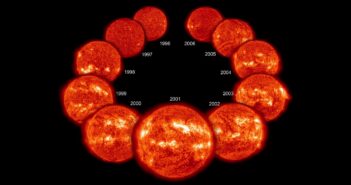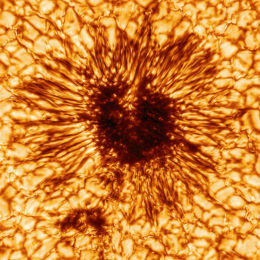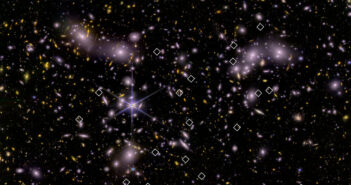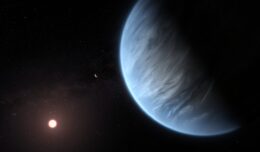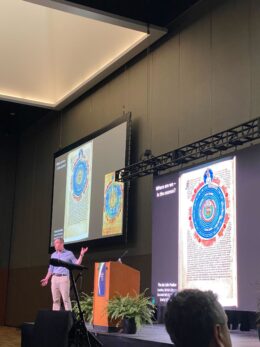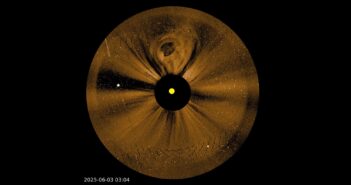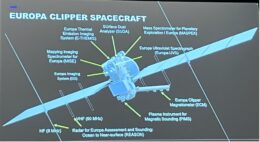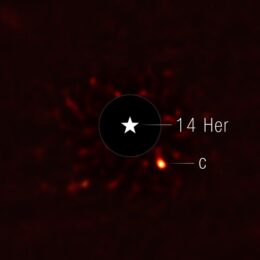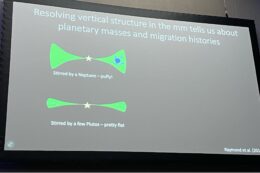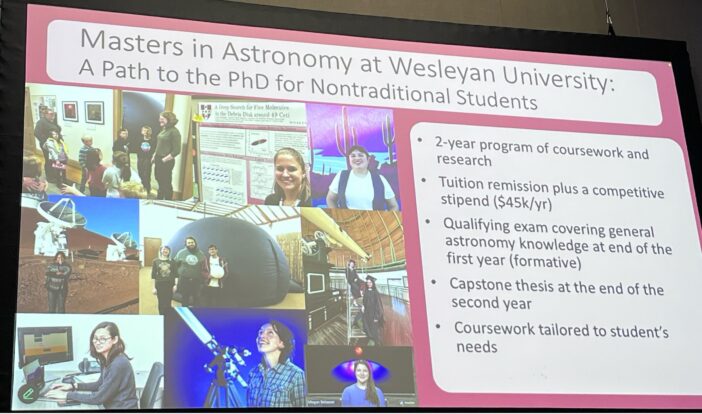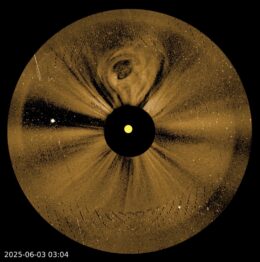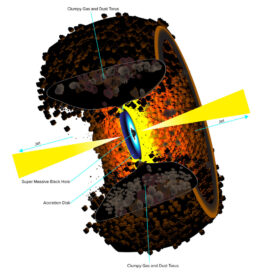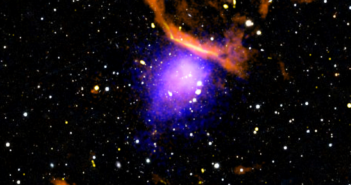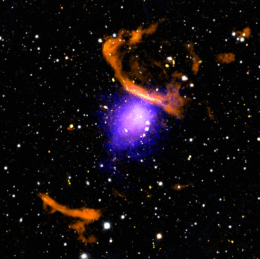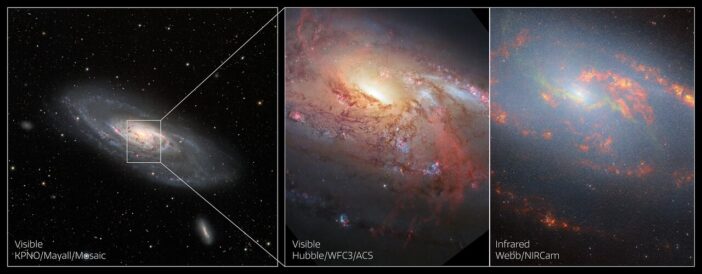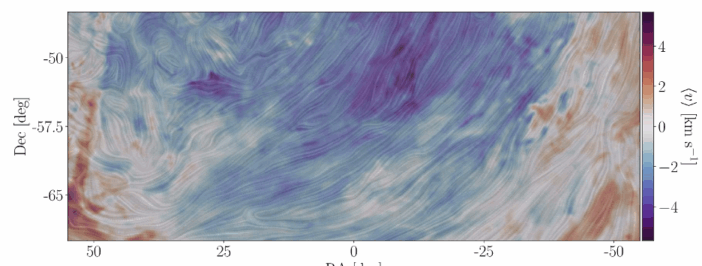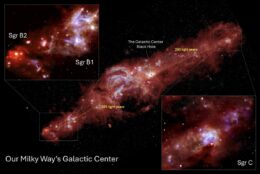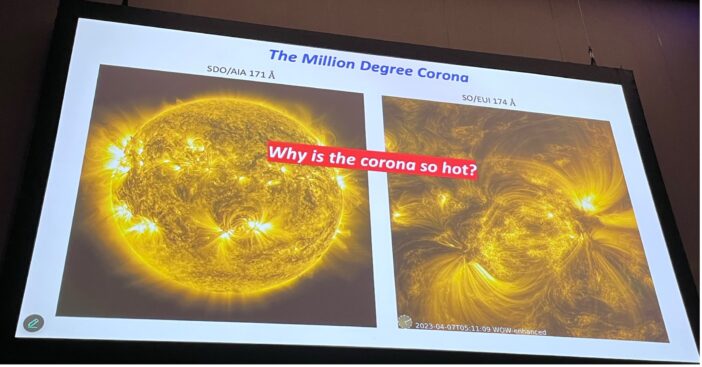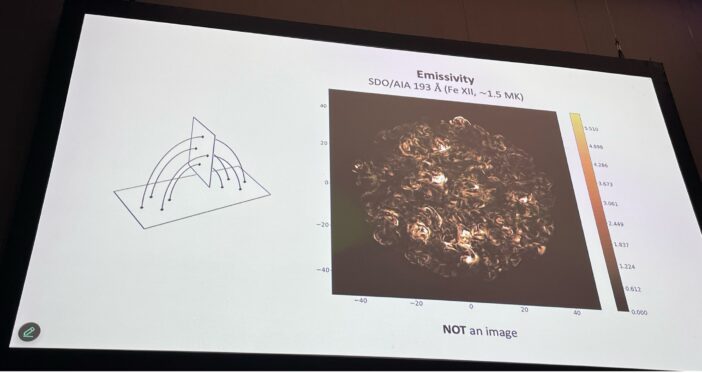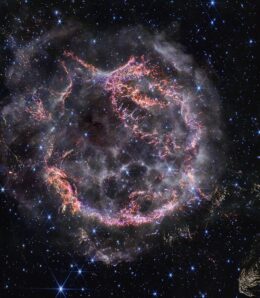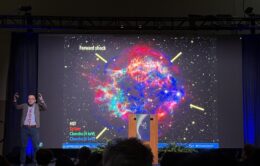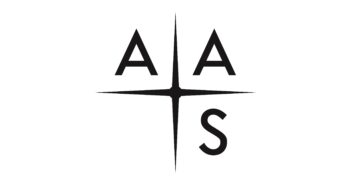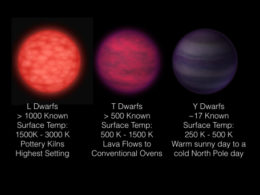Editor’s Note: This week we’re at the 245th AAS meeting in National Harbor, MD, and online. Along with a team of authors from Astrobites, we will be writing updates on selected events at the meeting and posting each day. Follow along here or at astrobites.com for daily summaries, or follow @astrobites.bsky.social on Bluesky for more coverage. The usual posting schedule for AAS Nova will resume on January 21st.
Table of Contents:
Plenary Lecture: The Star Formation Engine, Stella Offner (University of Texas, Austin) (by Jessie Thwaites)
“The story of a star’s life is written at birth,” says Dr. Offner, whose plenary lecture describes the details of numerical simulations to understand the birth and evolution of stars in our Universe. She and her team in the STARFORGE project have created some beautiful animations of their simulation output, which made for riveting visuals in her talk (they also publish them on their website, so check their movies out here!).
She begins with the stellar initial mass function (IMF), which is known from observations but that they want to describe with their simulation from first principles. It’s a difficult problem to solve — there are multiple scales and many processes at play, and although we have incredible observations from JWST for star forming regions like the Carina Nebula, which is actively forming thousands of stars, this is only a single snapshot in time.
The star formation engine is a process with many scales, starting from a molecular cloud in a galaxy, which has a dense core region with an accretion disk. A forming star may have a protostellar outflow or a wind bubble, depending on its size, and when it eventually goes supernova it launches material back into the galaxy, beginning the process over again. Dr. Offner’s simulations need to cover 10 orders of magnitude in space and 20 orders of magnitude in density (that means that if the smallest region is of order 1 in both space and density, making simulations that consistently model regions that are 10,000,000,000 larger and 100,000,000,000,000,000,000 times more dense, and everything in between) — a huge feat! To do this, they use Frontera supercomputers and hydrodynamic codes to attack this challenge.
Their codes include a variety of processes, from physics models for self-gravity (which tell them how the gas interacts with itself), magnetic fields, and turbulence, to stellar feedback mechanisms such as protostellar outflows, stellar winds, radiation, and supernovae. They combine these with important microphysics considerations, including heating and cooling mechanisms and cosmic rays.
In one animation, they begin with a cloud of gas 10 parsecs across and initial turbulence conditions. As the simulation evolves, complex structures begin to emerge, and the first protostars form. The protostars begin to have outflows reaching hundreds of kilometers per second, and as more stars form, they begin to form and interact with each other in clusters. The first high-mass stars begin to interact, and eventually slow down due to feedback and supernovae from these massive stars, until the center of the cloud can be revealed in optical light. Through this process they are able to reproduce the IMF conditions, and even with 15 more simulations they find a very similar IMF, reproducing the observed IMF.
One of the elements that is new in these simulations but is incredibly important, Dr. Offner says, is cosmic ray ionization in the clouds. These charged particles are responsible for heating the dense gas and eventually the formation of molecules, which make them especially important to astrochemistry. They find the cosmic ray energy has an impact on the IMF, which leads them to ask if regions with high cosmic ray densities (like the centers of galaxies) might have a different IMF than other regions. To study star formation in galaxies in addition to their simulations, they team up with the FIRE (Feedback in Realistic Environments) simulation team to produce consistent simulations from the galaxy scale down to an accretion disk around a black hole. They find that the IMF does change in their simulations depending on the distance from the center of the galaxy — an important result for understanding how stars form in galaxies.
There is still more work to be done, Dr. Offner says. The simulations can include still more physics models and astrochemistry, important for understanding how chemical compounds and planets form, which is important to studying habitability over time. Trying to follow all of these chemical considerations is too expensive with traditional simulations, but are excellent problems to approach with machine learning. She and her team at the newly established NSF AI Institute for Cosmic Origins are working to understand these problems using robust machine learning techniques.
Return to Table of Contents.
Splinter Session: The Habitable Worlds Observatory: Current Status and Opportunities for Engagement (by Lindsey Gordon)
This splinter session discussed NASA’s next flagship mission after Roman launches, the Habitable Worlds Observatory (HWO). This was the main mission recommended by the 2020 decadal survey, and will be a sort of “SuperHubble,” with similar wavelength coverage but a 6–8 meter aperture (Hubble’s aperture is 2.4 meters across). This will be the first instrument capable of directly imaging an Earth-like planet, but any object in the infrared through the ultraviolet can be observed. The mission will have a coronagraph, a high-resolution imager, an ultraviolet multi-object spectrograph, and a not-yet-determined fourth instrument that will be decided on by community demand.
Dr. Makenzie Lystrup, the director of Goddard Space Flight Center, opened the session by thanking everyone who is engaging with HWO. She emphasized the importance of community in the project, both in its development and its long-term usage, and Goddard’s commitment to executing the project on budget and on schedule to produce a mission that will be a major community resource.
We then heard from one of the leads of the Science Community Engagement team. They want to get both the scientific community and the public excited about this mission as it searches for life in the universe. There is an upcoming meeting, HWO25, and they hope to involve the community in the conversations there. The remainder of the session included presentations from the science working groups (Living Worlds, Solar Systems, Evolution of the Elements, and Galaxy Growth), industry partners, “pop” talks from Early Career Researchers, and a mini “Town Hall” with tables from different groups to start discussion.
You can find out more about HWO on their NASA website or by requesting to join their Slack.
Return to Table of Contents.
Splinter Session: A Conversation About the Gemini Observatory Strategic Plan for the 2030s (by Lindsey Gordon)
The Gemini Observatory ran a splinter session to discuss their 2023–2028 improvement plan and the future of the telescope. Scott Dahm, the interim director, discussed the new instruments. GHOST, IGRINS-2, GPI-2, SCORPIO, and GIRMOS are all going online in that timeframe at both the North and South observatories, and these instruments make up a set of new spectrographs and imagers that will improve Gemini’s capabilities. GNAO is the new adaptive optics system for the North observatory and is scheduled to go online in 2028. Gemini is also getting a new proposal writing and execution platform, the Gemini Program Platform, in coming years to streamline and centralize observing.
Gemini’s critical science areas include exoplanets, time domain (transient) astronomy, galaxy science, and star and planet formation. The observatory will play a key role in selecting exoplanet targets for JWST, performing rapid transient followup, and providing advanced adaptive optics for observations.
The science team & NOIRLAB are highly involved in public outreach and community based astronomy. They’re adding a cultural residency program this year, doing anti-light-pollution work to keep Chile’s skies dark, and just celebrated the 20th anniversary of their Journey Through the Universe program reaching thousands of students in Hawai’i. The team is also supporting the transition of the management of Maunakea’s observatories to the Maunakea Stewardship and Oversight Authority.
Return to Table of Contents.
Press Conference: Exoplanets: From Formation to Disintegration (by Lexi Gault) (Briefing video)
An ALMA Survey of Circumstellar Disks in Young Binaries
Taylor Kutra (Lowell Observatory)
Stars and their planets are born out of clouds of gas and dust that collapse over time, but frequently stars are not formed alone but rather in binary pairs or larger groups. In order to understand how planets form in binary star systems, it is important to study the environments where they are born — the circumstellar disks of their host stars. Dr. Kutra presented ALMA (the Atacama Large Millimeter/submillimeter Array) imaging of the circumstellar disks of binary star system DF Tau. Prior to ALMA imaging, Dr. Kutra thought that only the primary star in the system had a circumstellar disk and any remnant light was noise; however, with the ALMA images it became clear that both stars in the system are surrounded by a disk of gas and dust. These observations provide the basis for future investigations into binary star systems and their journey to forming planets. | Press release
A New NASA Mission to Characterize Exoplanets and Their Host Stars
Ben Hord (NASA Goddard Space Flight Center)
Dr. Hord shared updates and science goals from the new NASA Pandora SmallSat Mission that plans to observe and characterize exoplanet host stars and exoplanetary atmospheres. This is a space-based mission, employing a 0.44-meter telescope that can observe simultaneously at visible and near-infrared wavelengths. During its 1-year primary mission, Pandora will observe more than 20 known exoplanet systems, collecting data on the host stars’ light profiles as well as spectra to identify the composition of exoplanet atmospheres. These observations will allow astronomers to better understand exoplanet atmospheric conditions and will aid in the search for habitable planets. Pandora will be able to perform follow up observations on exoplanet candidates observed with JWST and will be a critical tool in the exploration of exoplanetary systems. | Press release
X-Rays in the Prime of Life: Irradiating Vulnerable Planets
Scott Wolk (Smithsonian Astrophysical Observatory)
When searching for habitable planets in the galaxy, astronomers often target low-mass main sequence stars (M stars) as they are the most common star type in the galaxy. Dr. Wolk presented observations of M star Wolf 359 that is very bright in the X-ray. This star is about 10% the mass of our Sun and its habitable zone is very close to the star. However, this star is pumping out tons of X-ray radiation that can evaporate an exoplanet’s atmosphere over the course of a couple million years. This is very detrimental to any potentially habitable planet, but Dr. Wolk explained the conditions required for a planet to still be habitable under these conditions. Earth, for example, has a very massive reservoir of liquid water in our oceans, which under these X-ray conditions, could replenish the atmosphere for an extra 600 million years. However, this is still not a very long time for life to develop or persist, and Wolf 359 has emitted multiple flares, which would expose the planet to even more damaging radiation. Is there any hope left? If a planet had a water reservoir equivalent to 11 times the amount of water in Earth’s oceans, it would continue to have an atmosphere, so while not all hope is lost, X-ray emission from M-type stars poses a significant threat to their planetary systems’ habitability. | Press release
Bright Star, Fading World: Dusty Debris of a Dying Planet
Marc Hon (Massachusetts Institute of Technology)
In exoplanet systems, if a planet orbits too closely to its host star, the star will heat the planet into an extremely hot ball of lava. A small enough planet, smaller than Earth, is not able to hang onto its atmosphere, and as it orbits its star, the material evaporated from the planet will form a comet-like tail of material trailing behind the planet. Dr. Hon announced the Transiting Exoplanet Survey Satellite discovery of one such disintegrating exoplanet BD+05 4868 Ab. Through their observations, they have found that the planet has a long trailing tail of material and a smaller leading tail. From their measurements, this planet is losing one Moon’s worth of mass every million years, which would destroy a small planet completely. This discovery opens up the realm of dying planets, and we can continue to learn about them with further observations. | Press release (PDF)
JWST Exposes Hot Rock Entrails from a Planet’s Demise
Nick Tusay (Penn State University)
In the theme of dying planets, JWST observations have revealed the disintegrating entrails of planet K2-22b. As Tusay explained, when planets are disintegrating, you can study the composition of their layers as they shed. Using the JWST data, they modeled the compounds in the dust cloud coming from the planet. These models show that the compounds are not consistent with iron-dominated material, suggesting that this planet has not yet been stripped down to its core, and the compounds are not consistent with rock vapor. Looking for other plausible materials, they find their data is most consistent with CO2 and NO, which are “ice” vapors. But how could this planet so close to its star have ice? Tusay suggests that this planet may have formed further out but was thrown inward by a binary star companion. Further observations of similar systems will aid in understanding dying planets and their origins. | Press release (PDF)
Return to Table of Contents.
Dannie Heineman Prize for Astrophysics Lecture: Past, Present, and Future Cosmic Microwave Background Surveys, John E. Carlstrom (University of Chicago) (by Bill Smith)
The cosmic microwave background (CMB) is one of the most important pieces of evidence for our modern understanding of the cosmos, and Dr. John Carlstrom has played a key role in the development of the interferometry techniques and telescopes that led to the precise measurements of the microwave sky we have today. He was awarded the Dannie Heineman Prize for Astrophysics, awarded jointly by the American Institute of Physics and the American Astronomical Society and funded by the Heineman Foundation, for his “pioneering work on microwave interferometry and his leading role in the development of the South Pole Telescope.”
He shared how his own interest in microwave astronomy was born out of studying the Sunyaev-Zeldovich (SZ) effect, in which microwaves from the CMB are distorted when passing through galaxy clusters en route to Earth. As Dr. Carlstrom said, the SZ effect leaves a “shadow” of sorts in the sky in the microwave spectrum in the vicinity of the most massive objects. Because this “shadow” measures thermal energy, it can be used as a proxy for the mass of the cluster. He recounts building the “SZ Array” with Marshall Joy to take low-brightness images over an extended period of time to successfully measure the SZ effect and use it to calculate cosmological parameters like Omega matter and the Hubble constant.
The next project he focused on was DASI, the Degree Angular Scale Interferometer at the South Pole. From DASI data, Dr. Carlstrom and his team were able to measure the matter power spectrum to a high enough precision to conclude for the first time that dark matter was needed in the very early universe and were able to measure the polarization of the CMB for the first time.
Following this, Dr. Carlstrom discussed the South Pole Telescope (SPT), and the many ways it is groundbreaking. He showed preliminary work of a galaxy cluster catalog developed with SPT data showing the relationship between redshift and cluster mass. He then highlighted multiple results from younger scientists in the collaboration observing transient phenomena, like stellar flares, blazars, and asteroids. Dr. Carlstrom continued by highlighting the importance of polarization and CMB lensing, and how measuring the E modes and B modes would allow insight into the gravitational waves generated by inflation, and thus insight into inflation itself. To measure the B modes, though, would require measuring fluctuations in the CMB on order of 10 nanoKelvin, which is still out of reach, but a new SPT camera being built could lead to a future measurement. He concluded with a quick look to the future, noting that the SPT has multiple datasets over multiple years at this point, and that a new telescope called CMB-S4 is also in the works.
Return to Table of Contents.
Seminar for Science Writers: Bringing the Night Sky to Life: NSF–DOE Vera C. Rubin Observatory Will Revolutionize the Way We Explore the Cosmos (by Kerry Hensley) (Briefing video)
Thursday afternoon brought a special session for science writers introducing the Vera C. Rubin Observatory. The observatory is currently under construction on Cerro Pachón, a mountain in the Coquimbo region of Chile north of Santiago. There, it is dry, high, and the nights are dark — critical factors for the exceptionally broad and deep science that the observatory will enable. Though the wait for this highly anticipated observatory has been long, the wait is almost over, with the first image to be released this summer and the full science survey to be underway by the end of 2025. The mission of the observatory is to bring the night sky to life, which it will accomplish by scanning the sky for 10 years and creating a time-lapse record of the universe — in other words, the greatest cosmic movie ever made. The observatory is also notable for being the first project of similar scale to incorporate education and public outreach from the project’s inception. “The universe is universal,” and the Rubin team aims for anyone who is interested to be able to get involved through formal education, public outreach, and citizen science.
First up in the seminar was Sandrine Thomas, who got the audience acquainted with the basics of the observatory and its namesake, Vera Rubin. Rubin was an astronomer who provided the first convincing evidence for dark matter and advocated for women in astronomy. Fittingly, the Vera Rubin Observatory is the first major US observatory named for a woman. And don’t forget the name! Though astronomers love acronyms, Thomas emphasized how critical it is not to reduce the observatory’s name to “VRO” (there’s a list of recommended name variations on the observatory’s media page).
Rubin Observatory’s mission is to capture the cosmos, and to do that, it needs a wide field of view, a speedy telescope, and the ability to see faint objects. The 3.5-degree field of view — equivalent to the area of 45 full Moons — and fast-moving 350-ton telescope enable the observatory to take repeated images of the entire southern night sky in 3–4 nights. The observatory boasts a 3,200 megapixel camera — the largest digital camera ever constructed — and six color filters from near-ultraviolet to near-infrared. Looking ahead, the camera installation will take place in March 2025, with first look expected June/July 2025 and the survey expected to start late 2025.
Leanne Guy introduced Rubin’s four key science areas: dark matter and dark energy, Milky Way structure and formation, a census of the solar system, and the changing sky. Designing a survey that can advance our understanding of all four of these areas is challenging, so the team worked collaboratively with the scientific community to set the survey cadence. The result is a survey that will generate 2 million exposures over 10 years, raking in 20 terabytes of data each night. The most frequently surveyed fields, the “deep drilling fields,” will be visited roughly 1,000 times in those 10 years.
The scientific yields are immense: for the Milky Way, the survey will produce a map 1,000 times larger than previous surveys. For our understanding of dark matter and dark energy, the wide field of view and faint object detection will provide an avenue to study these phenomena and explore alternate theories of cosmology. The solar system census will uncover four times more solar system objects than we currently know, changing the game for planetary defense, among other benefits. Finally, Rubin will detect 10 million changes in the night sky every night, uncovering rare events and enabling detailed follow-up observations. Speaking of follow up, Rubin can act as a follow-up facility in its own right, and Guy asserted that the observatory will be ideal for following up on gravitational wave detections.
Tackling the data discussion was Yusra AlSayyad, who demonstrated why an observatory like Rubin couldn’t be built until now: after all, only 20 years ago, we were still getting Netflix via DVDs! The same technology that has allowed streaming and social media to proliferate has also enabled this groundbreaking observatory, which will snap an image every 40 seconds, collecting 60 petabytes (that’s 60 quadrillion bytes) of data in 10 years. In just a single year, the survey will more than double the number of raw optical and infrared images in existence.
This massive dataset requires thoughtful data management and distribution strategies. Minutes after changes in the night sky are detected, alerts will be sent out to enable followup. But the number of alerts — potentially as large as 10 million per night — would be overwhelming, so Rubin will partner with community brokers who will filter these alerts and send out a whittled-down number. The facility will also produce annual data releases, culminating in a 500-petabyte final release. As this is far too large to download onto a laptop, data users will interact with the data through a cloud-based science platform.
Beth Willman from the LSST Discovery Alliance expanded upon the data distribution policies of the observatory. Rubin data will be immediately available to anyone in the US and Chile, as well as scientists from participating institutions. The data will become available to all two years after collection. Willman highlighted the global nature of the endeavor, with 28 countries contributing to the physical construction of the observatory or the creation of its software. “It’s not your mother’s science,” Willman said, emphasizing that the massive amount of data that will be produced represents both a challenge and an opportunity to create a new paradigm in how science is done. Part of that new paradigm will be infrastructure that facilitates the participation of professional and citizen scientists across the globe. And the impact is likely to extend beyond astronomy, as the data management and discovery methods can be applied to other big-data fields.
Finally, Stephanie Deppe closed the session by introducing resources to learn more, including the Rubin media kit, images and videos, an opportunity to visit the observatory site this spring, and opportunities to receive an email digest or press releases.
Return to Table of Contents.
Press Conference: Galactic Histories and Policy Futures (by Archana Aravindan) (Briefing video)
A Dwarf Galaxy’s Stellar Halo Built by Accretion
Catherine Fielder (University of Arizona)
This study by Dr. Fielder and team offers a rare glimpse into the evolution of a small dwarf galaxy, NGC 300, and its role in building stellar halos. While massive galaxies grow through mergers, forming extensive stellar halos, dwarf galaxies have fewer opportunities for such assimilation. Using deep imaging from the DELVE survey, resolved star maps reveal intricate structures around NGC 300, including a northern stream that extends over 100,000 light-years. The metallicity of these streams suggests they originated from a smaller galaxy that NGC 300 pulled apart, driving the formation of its stellar halo through accretion. This opens exciting opportunities for future exploration of how dwarf galaxies can form and evolve with Rubin and Euclid. | Press release
The Boundary of Galaxy Formation: Constraints from the Ancient Star Formation of the Isolated, Extremely Low-Mass Galaxy Leo P
Kristen McQuinn (Space Telescope Science Institute and Rutgers University)
Satellite galaxies typically follow a pattern of initial bursty star formation that is later followed by a period of star-formation quenching close to the epoch of reionization. However, Dr. McQuinn and collaborators find that one particular low-mass galaxy, Leo P, underwent a slightly different process. This isolated galaxy experienced three distinct phases of evolution: early star formation, a pause post-reionization, and a later reignition of star formation. Unlike satellite galaxies near massive systems, where environmental effects such as tidal stripping may entangle with reionization, Leo P’s isolation could provide crucial insights into the role of reionization in halting star formation. Similar patterns are also observed in other low-mass galaxies. Dr. McQuinn’s findings suggest that reionization may suppress star formation in galaxies larger than ultra-faint dwarfs, with varying effects based on environmental factors. If extended pauses in star formation are common, low-mass galaxies likely contributed minimally to reionization. | Press release
Resolving 90 Million Stars in the Southern Half of Andromeda
Zhuo Chen (University of Washington)
The Local Group of galaxies, particularly Messier 31 (the Andromeda Galaxy or M31), is an ideal laboratory for studying galaxy astrophysics. As the Milky Way’s closest large neighbor, M31 allows for detailed exploration, with the ability to resolve hundreds of millions of stars. The Panchromatic Hubble Andromeda Southern Treasury (PHAST) survey, of which Dr. Chen is a part, has produced the largest and sharpest photomosaic of the southern disk of M31, spanning decades and composed of 600 overlapping Hubble snapshots. The central region hosts older stars, while the southern disk features prominent dust lanes and young star-forming regions like NGC 206, along with numerous young star clusters. Observations also include Messier 32, a satellite galaxy dominated by older stars. Detailed analysis reveals that M31’s star formation history spans four age groups: very young (3–200 Myr), young (30–500 Myr), intermediate (0.8–2 Gyr), and old (> 2 Gyr). Tracking the older stars reveals a typical disk galaxy lacking visible spiral structures. Conversely, younger populations highlight more defined spiral arm structures, with the youngest stars creating the most pronounced features. | Press release
Recent Space Policy Statements Regarding Our Dark and Quiet Skies
John Barentine (Dark Sky Consulting)
The COMPASSE (Committee for the Protection of Astronomy and the Space Environment) empowers the astronomy community to advocate for preserving dark and radio-quiet skies, which face growing threats from satellite constellations, solar power infrastructure in space, and commercial space advertising.
To address these challenges, the AAS has issued key statements:
- Transparency in Spaceflight Activities: Space activities, including cislunar (space around the Moon) and interplanetary missions, should be conducted openly, with publicly reported trajectories.
- Atmospheric Impacts: Satellite launches and reentries contribute to atmospheric pollution. Congress needs to fund research to study and minimize their environmental effects and ensure that companies that launch satellites take them into consideration.
- Space Advertising: Obtrusive space advertising poses a significant threat to ground-based astronomy and should be prohibited. The US and AAS are leading efforts to prevent its proliferation.
COMPASSE has also endorsed the IAU resolution on protecting dark skies and engaged with the US State Departments to promote these goals. Through these actions, COMPASSE aims to safeguard the observational capabilities essential for advancing astronomical research.
Return to Table of Contents.
RAS Gold Medal Lecture: From the Cradle: Applying Basic Physics to Astrophysical Fundamental Questions, Gilles Chabrier (ENS-Lyon) (by Bill Smith)
In the spirit of collaboration between the United States and United Kingdom, it has become tradition for the winner of the Royal Astronomical Society (RAS) Gold Medal to present a lecture at a meeting of the American Astronomical Society, and the winner of the AAS’s Henry Norris Russell Lectureship to present at a meeting of the RAS. This year’s Gold Medal winner, Dr. Gilles Chabrier, presented on how ideas from statistical mechanics can inform our understanding of star formation and cosmology.
His goal for the first half of the lecture was to explain his theory for the stellar initial mass function, which is a probability density function that describes the initial masses of a stellar population. He began by reviewing random field theory and how it is based on two random fields, a velocity field and a density field, occupying a space. One can think of the giant gas clouds out of which stars form as a turbulent gas. That turbulent gas, however, also self-attracts under the force of gravity. Dr. Chabrier went on to show how these dual influences, turbulence and gravity, will result in overdensities collapsing into masses following a log-normal probability density function with two power-law tails.
After that, Dr. Chabrier focused on irreversible processes in cosmology. He explained how in our standard understanding of the universe’s expansion, the inhomogeneities in the universe are negligible in redshift, but that the question of homogeneity is coordinate dependent. He suggests the introduction of a local expansion rate to fulfill the need for a covariant calculation of the cosmological redshift. He then explains that large-scale structure can also be thought of as a result of this turbulence generating a random field in which overdensities develop due to the influence of gravity. For dark matter, which is collisionless, large-scale structure forms when dark matter particles begin crossing trajectories (called shell-crossing). This leads to turbulent flows with overdensities that collapse into what we know as dark matter halos. As Dr. Chabrier points out, though, this is an irreversible process, which produces entropy. This entropy production plays a crucial role in the expansion of the universe, and Dr. Chabrier concluded by arguing that the cosmological constant appears as a proxy to account for the entropy production of the expansion rate.
Return to Table of Contents.
Lancelot M. Berkeley − New York Community Trust Prize for Meritorious Work in Astronomy Lecture: Erik Tollerud (Space Telescope Science Institute), Clara Brasseur (University of St Andrews), and Kelle Cruz (CUNY Hunter College and American Museum of Natural History) (by Bill Smith)
Writing the line of code “import astropy” has become a rite of passage for nearly every astronomy researcher, and many people in the astronomy community have long noted the unrecognized and undervalued work that has gone into creating and maintaining software. This year, the AAS recognized this work by awarding the Lancelot M. Berkeley − New York Community Trust Prize for Meritorious Work in Astronomy to the entire Astropy collaboration “for their work developing and maintaining this code base, which provides underlying support for much of astronomy research as it is conducted today.”
Accepting the award on behalf of the entire collaboration were Dr. Erik Tollerud of the Space Telescope Science Institute, Clara Brasseur, a graduate student at University of St. Andrews, and Dr. Kelle Cruz of Hunter College. They began by playing an extensive list of all of the people who contributed to astropy on the big screen and thanking them for their contributions, then divided the talk into three parts that described the past, present, and future of Astropy.
Dr. Tollerud began by recounting Astropy’s origin story to a time in 2011 when he had to transform astrophysical coordinates and found himself struggling to navigate the many packages available. When reaching out to a mailing list about his idea for a more standard package, he was met with skepticism that it would be yet another package to navigate. He then explained how an initial group decided that this package would be developed differently. First, it would utilize Github (which was new at the time) for better collaboration, and adopt a “do-ocracy” philosophy, which Dr. Tollerud explains as “the work that gets done is the work someone will do.” He also credits the organizational structure of the early developers, saying “if you make the right structure, even cats can be herded.”
Dr. Cruz then described the current successes and challenges of the Astropy collaboration. She cites the original Astropy paper as being on track to be one of the most-cited astronomy papers ever as a resounding success. She also cites the thorough testing and stability of the core package as another success. She goes on to explain that the success of Astropy has presented new challenges. First, because Astropy is now such a critical piece of infrastructure for much of the astronomical community, including for most missions, testing and stability of the code are more critical than ever, requiring more resources and making it more challenging for people newer to software engineering to contribute. She then explained Astropy’s package structure, which includes core packages, coordinated packages, and affiliated packages.
Dr. Cruz also explained the governance structure of the collaboration, which included adopting a charter and policies for transparency. She also shared details about the Astropy collaboration’s increasing success in securing funding for the project. She thanked the many institutional contributors and highlighted contributions from the Flatiron Institute and NASA.
Clara Brasseur concluded the plenary by discussing the future of Astropy. They discussed how the core codebase is in a “maintenance phase,” but that maintenance for a software package like Astropy is still a lot of work, including bug reports, documentation, tutorials, and more. They highlighted a huge area for growth, Astropy Learn: a new website that hosts tutorials, mainly in the form of Jupyter notebooks, on many of the astropy modules. Clara concluded with a call to the audience to get involved and noting the possibilities that contributing can bring, saying “I’m a graduate student, and I’m up here giving a plenary talk! We have a place for any type of contribution.”
Return to Table of Contents.
